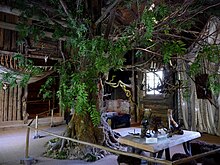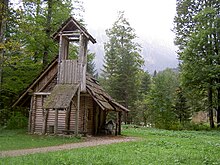Dog kennel

The Hundinghütte is a romantic log building in the park of Linderhof Palace in Upper Bavaria ( Ettal municipality , Garmisch-Partenkirchen district ). The small architecture, reconstructed in 1990, originally stood a few kilometers west of the castle in the Ammerwald .
The Hundinghütte in the Linderhof Palace Park
In 1876, the year of the first Bayreuth Festival , Ludwig II had his Hundinghütte built deep in the Ammerwald, far from Linderhof Palace near the Austrian border.
The hut was built according to a description of the scenery from Richard Wagner's first act of the Valkyrie .
The interior of a living room. In the middle stands the trunk of a mighty ash tree, the strongly raised roots of which are lost far into the ground; the tree is separated from its tops by a timbered roof, which is cut in such a way that the trunk and the branches extending on all sides pass through exactly corresponding openings; the leafy treetop is believed to spread over this roof ...
Under the Kreuzspitze, near the Linder spring, this Germanic dwelling was built from round beams; around an oak in which the sword Nothung was stuck, which Siegmund, to the delight of Sieglinde, pulls out with a mighty tug .
Like Siegmund once in the hut of Hunding , Sieglinde's husband, King Ludwig II fled here to the wooden hut, hidden deep in a mountain valley southwest of Linderhof. Luise von Kobell reported that her Majesty sometimes sat there alone for hours, absorbed in some kind of reading, the content of which stood in sharp contrast to the primitive bearskinism that surrounded him. Or he delighted in the living pictures presented by a meadows staged on demand in the old Germanic style.
The hut burned down on December 18, 1884, but was immediately rebuilt. In 1945 it was again a victim of the flames through arson , whereby part of the furniture and fittings (including an antler chandelier and two drinking horns) were preserved.
In the summer of 1990 the Hundinghütte was rebuilt in a new place closer to the castle. A reconstruction at the original location was originally planned, but a. could not be carried out for reasons of nature conservation. The new building in the east of the park is based on the original plans, views and sections in the King Ludwig II Museum, some of which are dated “August 1876”. A tree is growing again from inside the reconstructed log cabin (17.70 × 10 m). A double beech was placed in the new building using a crane . In front of the hut - according to the original plans from the office of the court building director Georg Dollmann - a small artificial lake was created.
Further reconstructions and conversions from the Ammerwald
In 1999/2000 private donations made it possible to reconstruct Gurnemanz's hermitage (Gurnemanz in Richard Wagner: Parsifal , 3rd act). The hermitage originally stood near the original Hundinghütte and fell into disrepair in the 1960s. The replica was placed just 150 meters west of the new Hundinghütte.
The two wooden buildings are the easternmost park structures in the spacious palace park. Nearby, the gardens are closed off by the Forbidden Gate . The densely forested southeast part of the park was enhanced by the two reconstructions and the small lake. To the northwest of this area is the former construction hut of the architects and craftsmen who were involved in the construction of the palace and the creation of the gardens.
The Moroccan House has also been in the park since 1998 . This pavilion was acquired by the king at the Paris World Exhibition in 1878 and rebuilt on the Stockalpe in the Ammerwald. In 1980 the Free State was able to buy back the building from a private individual. This small architecture has been located in the northwest of the park near the main entrance since it was re-erected.
Coordinates: 47 ° 34 ′ 12 ″ N , 10 ° 57 ′ 58 ″ E
literature
- Hans F. Nöhbauer: In the footsteps of King Ludwig II. A guide to castles and museums, places of life and memorials of the fairy tale king. 2nd edition edited by the author. Prestel, Munich 1995, ISBN 3-7913-1470-X .
- Detta Petzet, Michael Petzet : The Hundinghütte of King Ludwig II. The stage design for Richard Wagner's "Walküre" and the reconstruction of the Hundinghütte in the Linderhof Palace Park (= workbooks of the Bavarian State Office for Monument Preservation. Vol. 51). Bavarian State Office for Monument Preservation, Munich 1990, ISBN 3-87490-536-5 .
- Marcus Spangenberg: Linderhof. Buildings and dreams in the mountains , Verlag Friedrich Pustet, Regensburg 2018, ISBN 978-3791728049 .


